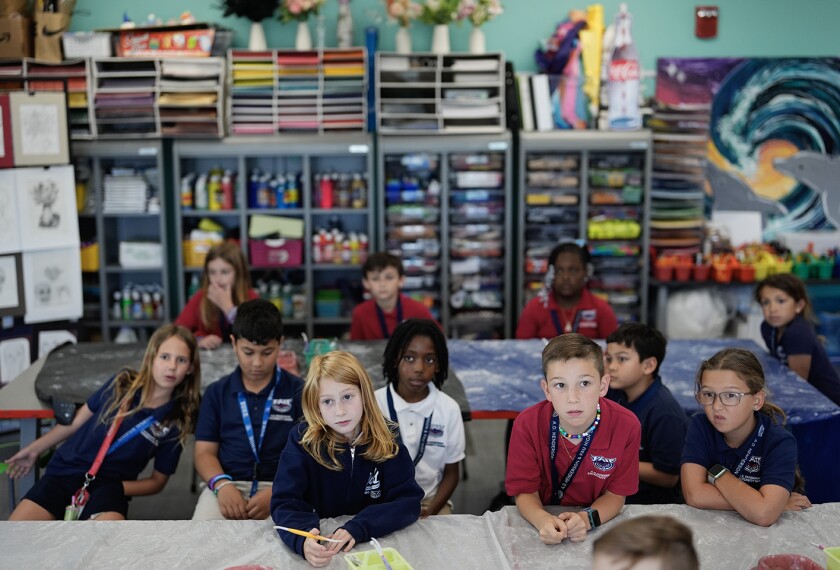Cat Briggs has spent the last decade driving a bus every morning and afternoon during the school year for the Rosemount schools in Minnesota. She calls it the best job she’s ever had.
Before that, she worked grueling hours year-round as a paralegal. Spending two or three months during the summer with no job and no source of income was a new experience.
But when school wasn’t in session, she found herself falling behind on mortgage payments and scrambling to find local employers that would hire her for only two months at a time.
“You’re not making a windfall working for a school district. Every little dollar counts,” Briggs said. “Not having any wage in the summer really, really hurts.”
That all changed in May 2023, when Minnesota became the first state in the country to pass a law making cafeteria attendants, bus drivers, paraprofessionals, and other K-12 school workers who are not teachers or administrators eligible for unemployment benefits during the summer, even if they’ve been assured they’ll have a job come fall.
The provision was part of a larger education package that also boosted state school aid and instituted new reading instruction requirements. It was signed into law by Gov. Tim Walz, a Democrat who is now No. 2 on Vice President Kamala Harris’ presidential ticket.
Minnesota is one of a handful of states that have taken steps in recent years to help school workers who go without pay during the summer. Oregon’s governor signed a law similar to Minnesota’s weeks after Walz; it took effect in January. Illinois and Nevada made similar offerings during the pandemic, but those measures were only temporary. Kansas earlier this year extended summer unemployment benefits to school bus drivers employed by private contractors.
California in 2019 established a Summer Bridge Fund program, through which eligible workers contribute a small chunk of their paycheck during the school year and get it back during the summer along with a matching amount from the state. The state assembly last month extended that program through 2025.
If every state were to make school workers outside the classroom eligible for unemployment insurance (UI) benefits, employees would collectively earn $1.2 billion more per year than they currently do, according to a forthcoming data analysis from the Economic Policy Institute, a left-leaning think tank. Spending on K-12 education would increase by no more than half of 1 percent in any state if workers claimed unemployment benefits at the same rate they did during the first summer the Minnesota law was in effect, according to the group’s research.
“We have created a series of jobs that are vitally important to the teaching of our kids but we don’t give them year-round wages, and they don’t even get 40 hours a week,” said Dave Kamper, a state policy strategist for EPI, who helped craft and study the potential impact of the Minnesota legislation. “By taking that job, they’re foreclosing the possibility of full-time employment year-round. UI is a reasonable step to address that.”
Some school district leaders don’t agree, though. Paperwork and legal proceedings are piling up as Minnesota and Oregon districts provide required information to state unemployment administrators and fight claims they believe aren’t legitimate. Opinions differ on whether increasing workers’ salaries or expanding unemployment benefits is a more effective strategy for supporting workers in a financially prudent way.
On a more practical level, districts in states with expanded unemployment benefits for school workers are shelling out hundreds of thousands of dollars to cover unemployment benefits for their employees, sometimes without additional state funding.
Sharie Lewis, director of business services and operations for the 2,800-student Parkrose school district in suburban Portland, Ore., says she told leaders of the unions that represent her district’s staff, “‘If I don’t have the money, it’s going to hurt negotiations in the future. It doesn’t grow on trees, guys.’”
Districts aren’t used to handling so many unemployment claims
When state unemployment systems approve insurance benefits for K-12 school workers, school districts are typically responsible for reimbursing the state for the full cost of those benefits.
Federal law prohibits teachers and other instructional workers in K-12 schools from receiving unemployment benefits during the summer. Individual states can extend benefits to educational workers who aren’t in the classroom, but they have to proactively pass a law to do so.
Until recently, schools typically dealt with unemployment claims in a handful of rare situations: when full-time employees shifted to part-time status, when employees were laid off or furloughed for budget reasons, and when part-time employees qualified for unemployment benefits from a different employer.
Now, classified school workers in Minnesota and Oregon don’t need to demonstrate that they expect to lose their jobs next school year to qualify for unemployment benefits during the summer. They do, however, need to follow all the typical rules for unemployment benefits, including that they regularly apply for jobs elsewhere.
“There’s nothing unique about these requests,” said Mary Haugen, a spokesperson for the Minnesota Department of Labor. “It’s managed like any other UI claim in Minnesota.”
Lewis said she’s received an email nearly every day this summer with a new request for unemployment benefits. Out of slightly fewer than 100 classified workers in positions that don’t extend to the summer months, Lewis estimates that one-third to one-half have applied.
Each time, she has to share with the Oregon Department of Labor when the employee worked, whether they’re guaranteed a job, how much they’re paid during the school year, how much money they earned in recent months, and lots of other details.
In Lewis’ district, the state denied more than half the filed claims. “We don’t get to know why,” Lewis said.
The state hasn’t provided districts with new funding to cover the cost of these unemployment claims.
The situation is different in the Osseo district in Minnesota. Nearly all of the employees who applied for unemployment benefits last summer and this summer have been approved, said John Morstad, the district’s executive director of finance and operations. Sometimes, the district challenges those approvals but it rarely wins, he said.
Before Minnesota changed the law, the 21,000-student Osseo district typically spent $100,000 a year on unemployment benefits. State law permits the district to pass on those costs to local taxpayers. For a district of 156,000 residents, that meant adding mere pennies to most people’s property tax bills.
But last year, as school workers became eligible for unemployment benefits just days before the school year ended, the cost of unemployment benefits jumped to more than $800,000, Morstad said. This summer, that sum is on track to exceed $1.5 million.
Districts in Minnesota can’t pay for these expanded benefits by increasing local taxes. But so far, they haven’t had to pay a cent of their own funds to cover them. Minnesota established a $135 million unemployment benefits trust fund from which districts can pull, and districts used only $40 million in 2023.
But by next year, Morstad suspects, those funds will have run out. He and other district leaders plan to lobby the legislature for more state funds to cover the ongoing costs, which are likely to rise. If the state doesn’t come through, the district will have to spend roughly half its annual allocation of state funds on unemployment benefits alone.
“That will result in a direct impact on the classrooms to have to come up with that extra cost,” Morstad said.
Some observers wonder if unemployment insurance is the best mechanism
The unemployment insurance system school workers in some states are now entering is far from perfect. Established under the Social Security Act of 1935, the federal government sets broad unemployment insurance rules, but each state administers its own benefits program—most of which are insolvent as claims outpace available funding.
Only roughly 1 in 4 unemployed workers nationwide receive unemployment benefits. For many workers who do get benefits, the periodic allotments—$449 per week on average, as of June—aren’t enough to get by.
Some proponents of unemployment insurance for hourly school workers concede that higher wages and more work opportunities for school employees would eliminate the need for supplemental income.
The median wage for food service workers in schools is $16.80 per hour, according to the Bureau of Labor Statistics. Paraprofessionals earn a median annual wage of $35,550, and school bus drivers earn slightly more than $20 per hour, according to federal data.
Achieving those goals dovetails with helping students as well—if paraprofessionals and bus drivers are working during robust summer school programs, they wouldn’t qualify for or need unemployment benefits, said Max Arias, executive director of the Service Employees International Union Local 99, which represents 35,000 classified employees in several K-12 school districts in southern California.
“That is kind of the dream job for the summer,” Arias said.
But in Los Angeles and other California cities, workers often don’t know until shortly before the school year ends whether their school will remain open during the summer.
“If you find a job [elsewhere] in the summer and then you’re asked to work [at the school] and then you don’t take it, it doesn’t look good for you,” Arias said.
In the absence of broader pay raises, unemployment benefits could entice more workers to stick around in their districts rather than looking for summer work and not returning to their school jobs in the fall.
Morstad said shortages of paraprofessionals in his district have become less severe since the height of the pandemic, though he’s not sure to what extent unemployment benefits are responsible for the improvement.
Making more school workers eligible for unemployment insurance could help governments respond more quickly the next time an emergency like the pandemic causes economic turmoil, said Michele Evermore, a senior fellow at the Century Foundation, who served in 2021 and 2022 as deputy director for policy in the U.S. Department of Labor’s Office of Unemployment Insurance Modernization.
Minnesota and Oregon are unlikely to remain the only states where this topic comes up for discussion. “I expect we’ll see a lot of campaigns for it in 2025—not just in blue states,” Kamper said.
The potential upside for workers is substantial. In the Osseo district, collecting unemployment checks for the roughly 10 weeks when school isn’t in session amounts to a 10 percent increase in annual pay for many school workers.
“A single-year, 10 percent raise is well beyond what a school district gives,” Morstad said.
For workers like Briggs, the Rosemount, Minn., bus driver, that increase can make a major difference. She knows colleagues who are using the checks to pay for elderly parents or siblings to stay in nursing homes. If they weren’t getting that additional money, she said, they might have to leave their jobs to take care of those family members themselves.
She’s found herself feeling less pressure to “live frugally” and build up her savings during the school year.
“I’m not saying you’re going to be going to the casino. You’re not going to be eating steak every night,” Briggs said. “But it’s doable.”
Disclaimer: The copyright of this article belongs to the original author. Reposting this article is solely for the purpose of information dissemination and does not constitute any investment advice. If there is any infringement, please contact us immediately. We will make corrections or deletions as necessary. Thank you.







